What You Know If You're From...
The What You Know documents are intended to provide players with a sense of what their character would and would not know, based on their place of origin. If you have questions that aren't answered by the document, please feel free to contact a helper, or post the question on the discussion board.
It is highly recommended that new players make their first character from Allanak or Tuluk, since there are more people to roleplay with in those main cities. Opportunities for jobs, friends, and other interaction are limited in other locations.
The following important facts will be familiar to anyone either from the cities, or who commonly enters them. Only the most naive or inexperienced tribals will not have heard rumors and stories of how the cities work.
- Anyone in any position of power is almost certainly corrupt and everyone knows it.
- Militia soldiers (who also act as the city's police force) are paid a pittance and yet live fairly well. Everyone assumes this is because they are corrupt and taking bribes.
- No one in their right mind in either city-state would openly complain about any type of corruption in the militia or templarate. In Tuluk, those who do simply vanish without a trace. In Allanak, those who do are generally publicly tortured.
- In Tuluk, it is not an insult to call someone a thief or assassin. It is an insult of grave proportions to call them an amateur thief or amateur assassin.
- People are (rightfully) frightened of the templarate in both cities. Rumors of people vanishing in the night abound in Tuluk and keep complaints out of public forums. Constant displays of ferocious violence in Allanak keep pretty much everyone quiet in public. Those who are captured and value their lives generally know that both bribes and shows of respect for their captors are their only hope of survival.
- Modern concepts of fair trials and justice are simply nonexistent in Zalanthas. If you are accused, you are guilty until someone important decides you might be useful. It doesn't really matter if you did it or not.
- Luir's Outpost is a place that people from either Allanak or Tuluk might visit, as well as many tribal peoples. It's known that House Kurac is the sole authority in Luir's Outpost and that unlawful behavior is usually punished by death.
What You Know if You're from Allanak
Geography
Allanak is a large city-state located to the south of a vast, nameless desert, and north of large, dusty flatlands. The city itself is situated within a narrow band of rocky wastelands in between. East of the city are huge salt flats, beyond which nobody has had the vigor to travel. Beyond the dusty plains in the south is the Sea of Eternal Dust, whose various surrounding villages provide the backbone of Allanak's economy. North of the desert is a huge mountainous cliffside known as the Shield Wall, beyond which few people, aside from desert merchants, have passed.
The city itself is divided into six main "quarters" -- The Commoners' Quarter, the Merchants' Quarter, the Nobles' Quarter, the Templars' Quarter, The Elementalists' Quarter, and the Labyrinth. The Commoners' Quarter in the west contains tenements and apartment buildings occupied by the city's common people, as well as taverns and a few shops. The Merchants' Quarter contains a large bazaar and various merchant estates within the northeast section of the city. The Templars' and Nobles' Quarters, located on the south and east sides of the city, respectively, each contain residences of the city's rulers. The Elementalists' Quarter, in the northwest of the city, is where the feared magick users are segregated. The Labyrinth is a crumbling network of alleys in the far northern end of the city, originally a new merchant district, but has since been abandoned and turned into a haven for the city's thieves and smugglers.
-
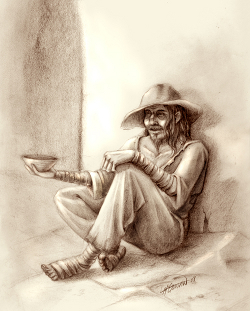
"The Beggar of Meleth's Circle"
Player artwork by Silverfaune
Society
The life of an Allanaki citizen is one of strife--expensive and degenerate living conditions, a nearly omnipotent ruler and His Templars watching your every move, and no place to hide except the burning wastelands outside the city gates. Highlord Tektolnes inspires a silent paranoia in all of his subjects, and thus has remained unchallenged during his multi-millenial reign. Most Allanakis are slaves belonging to the nobles and Templars, and the commoners are usually of the merchant class, employees of noble houses, or soldiers in Tektolnes' army. The rest of the population earn their living in less honest ways.
Templars are His Gloriousness's elite soldiers and spellcasters. Their power comes from Tektolnes Himself rather than from the elements, more deadly but with few applications aside from destroying people who pose a threat to Him. Templars basically have the power to act as judge, jury and executioner, and don't hesitate to use it whenever they desire.
The nobles spend their careers gathering popular support, serving in the senate, or otherwise advancing the goals of their houses. Nobles are accustomed to a very luxurious lifestyle, far beyond the means of the commoners. Many commoners may have little idea what a noble's life really entails, but they know that nobles are simply a better breed than they.
Economy
Allanak's economy, though still strong, is currently under much stress. Some years ago, the city's "divine" ruler, His Gloriousness Highlord Tekolnes, issued a city-wide ban on most types of mind-influencing spices in what some have (quietly) called an insane attempt to "purify the minds of His subjects", as His Senior Templar (and bastard child) Cohran Tektolnes put it. Allanak is still one of the richest civilizations on Zalanthas, however, with two major Merchant House bazaars, and a main bazaar for other trading. The Four Great Merchant Houses are Kadius, Salarr, Nenyuk, and Kurac. House Kadius is a House based in Allanak which trades (for the most part) in furs, skins, jewels, and other rarities. House Salarr, a "nomadic" House, has emporiums in many small villages as well as cities, and deals in weapons, armor, and other tools of war. House Nenyuk handles the city's banking and real estate - they are the slumlords of nearly every commoner. House Kurac has historically strained relations with city government, and while at times they sell desert gear within the city walls, their spice trade is banned.
Government
While the Allanak Senate, a gathering of nobles, meets yearly to decide matters of policy and law, the real power in Allanak is the Highlord. Every whim of His Gloriousness Highlord Tektolnes becomes Allanaki law immediately, through the actions of His Templars. He never goes out alone into the city's dirty streets, because of His distrust of the commoners and desire for seclusion. Instead, the Templars orchestrate His plans to the letter. He trusts them no more than the people of His city, but He realizes that they fear His powers too much to act against Him.
What You Know If You're From Tuluk
Geography
Tuluk lies at the southeastern edge of a broken and dried wood known as the Grey Forest. To the south are flat scrublands, which eventually give way to barren deserts, and to the west and southwest lie scrub forests and, further on, plains of short brown scrub. To the east lie vast plains, inhabited by the nomadic Anyali and a few tribes of elves. The Grey Forest itself remains largely unexplored, due to the deadly predators that live deep within its shelter. The trees of the forest are short and often thorny, bearing spearlike purple leaves and having a thick red-to-grey bark, and woods such as agafari, baobab and cynipri find their way across the surface of the world from the wood gatherers who work the outermost outskirts of the forest.
There are seven distinct subdivisions of the City of Tuluk, famed for its architecture and its culture: Freil's Rest which is also known as the Merchant's District, the Red Sun Commons, the Warrens, the Tribal Market, Poet's Circle, the Old Quarter, the Heart of the Ivory which is the templars' district and contains the Ivory Pyramid, and lastly the Nobles' Quarter. The Commoners Quarter (Warrens) and the Mercantile Quarter of the new city are by far the largest portions, both in terms of area and population. These quarters occupy the western portion of the Scaien. Just to the east of them, and south of the Old Quarter, are the Templars' Quarters and the Nobles' Quarters. North of the Old Quarter lies the area that the city- state has set aside to accommodate the large number of tribal merchants that enter the Scaien walls to barter for goods. The bardic history of Tuluk has been resurrected with the completion of Poets' Circle, just east of the tribal quarter. Centered within the city, the artisan district serves as the hub for Tuluki culture. Also known as the Red Sun Commons, this district is where the craftsmen and tradesman come to perfect their craft and display their talents.
Just off the main road leading into the city, a few blocks east of the western Scaien Gate, lies a walled off section in which a magnificent and lush tree of unknown origin grows. Current legend has the tree sprouting up from the blood of the fallen Jihaen Precentor, Isar. But in truth, no one really knows what the tree is or where it came from. It merely appeared shortly after the battle to reclaim Tuluk and is regarded as a symbol of freedom and good fortune.
Society
-
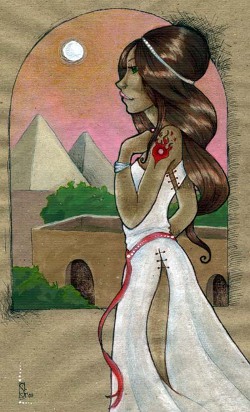
"Eyes of the Sun King"
Player artwork by Ourla
You probably grew up in an apartment or tenement in the labyrinthine Warrens, the commoner housing quarter in the southwestern part of the city. You are probably a commoner and therefore wear the traditional Tuluki tattoos that denote your caste, including the tattooed neck band that all citizens of Gol Krathu sport, and the six-pronged star on the hand that shows you are a commoner.
Despite the fact that no currently-living Tuluki citizens were alive during the destruction of the city-state at the hands of powerful elementals, the burning fear and hatred for the chaos wreaked by these creatures has instilled an inimitable hatred for all things magick within the hearts and souls of the population. The former temples to the elements were not reconstructed when the city-state was rebuilt. Magick is outlawed within the Gol Krathu region and its surroundings and no distinction is made between a defiler and an elementalist when one is discovered practicing these arts. Execution is swift and brutal, and many discovered to be magickers do not live to face the Templarate. Psionic talents are viewed in much the same way, but those with psionic talents are usually not slain, but enslaved into the service of the Lirathans and never seen again.
While the lands of the north are not nearly as harsh as those of the south, Tuluk is not, by any stretch of the imagination, a democratic state that values the rights of the individual. Consequently, slavery is a common practice within the city-state and House Winrothol is a driving force in this industry. Their talents at breeding muls are currently somewhat limited, but they have become artists at training new slaves. On extremely rare occasions, it is possible for a slave to earn his or her freedom. In these instances, particularly for muls, the slave is given a medallion that displays their freedom for all to see. Often, though, this is overlooked and the medallion has a habit of disappearing if the former slave is questioned.
Anti-southerner sentiment runs high at times and while northerners may travel, they tend to go no further south than Luir's Outpost, owned by House Kurac, which manages to tread a fine line between southern and northern alliance.
Economy
The primary economy of the northlands centers around hardwoods hewn from the Grey Forest. Agafari and baobab woods are the most common, but maar and cynipri also make up a large portion of the take. The majority of the northerners subsist on the fruits and nuts gathered from the surrounding scrub forests, and the game hunted from the deeper growth of the Grey Forest itself or else the plains that lie to the east. Excesses of these fruits, along a variety of leathers, complement the income from hardwoods. Duskhorn, taken from a beast with the same name, is also a substantially profitable material in the north, as is tortoiseshell taken on bahamet hunts.
The Great Merchant Houses also have large emporiums in the Northlands. After the initial destruction of Tuluk, House Kadius founded an entire village, although it has since become the mercantile district for the rebuilt city-state. Both House Salarr and House Kurac have established emporiums within the new city-state, though Salarr has had shops since shortly after the founding of Freil's Rest. Nenyuk, the banking and apartment-rental house, has also maintained a consistent presence in the north since the early days of Tuluk.
Government
Unlike Allanak, the city-state of Tuluk has no true Senate. Instead, the government operates in a tricameral fashion, made up of the noble faction, the Templar faction, and the Sun King's faction. The latter was and presumably still is composed of a single individual, Muk Utep himself, while the Templarate is divided into strict divisions. You have never seen Muk Utep, but you are sure he exists.
While originally composed of both Hlum and Surif nobility, the new government has done away with the Hlum titles for the most part, the exception to this being the title of Nobility that is granted to the winner of the Grey Hunt, a contest held roughly every 7 years, or 11 such contests per King's Age.
Wars and the subsequent liberation of Tuluk have trimmed the many orders that once existed within the Templarate, leaving only two surviving structures: the Lirathan order and the Jihaen order. With the liberation of Tuluk, the Lirathans assumed almost total control and the Jihaens were relegated to a lesser role within the government. However, these distinctions are always subject to change.
You know that, as in the early days of Tuluk, two types of law exist within the citystate: the King's Word and the State Law. The first variety has never been voted upon by the full government, yet is still practiced out of fear of Utep's power. The second variety has been passed by a two-thirds (or more) vote of all three factions and is, literally, written in stone.
What You Know If You're From Luir's Outpost
Geography
Situated in the largest gap through the Shield Wall, the Outpost is in an important strategic location for both war and trade. To the north of the Outpost, the North Road runs between cliffs leading to both the northlands and the tablelands. To the south, the Red Desert is an ever-changing land of storm-swept dunes that conceal fearsome predators and mysterious ruins.
To the southwest of the Outpost and within a score of leagues is the best-known of the ruins. Sometimes referred to as "The Blue Caverns" or "The Defiler's Tomb" this large area is much talked about but rarely explored. Quiet stories are spread of the ghost that supposedly haunts these caves and steals the life from those that trespass into its domain. Rumors of walls of whirling blades that rove the caverns seeking victims, lances of extreme cold that numb and burn without leaving a mark and the feeling of lips sucking life-force from those that venture there are all common.
The road leading northwards from the Outpost is a natural ambush site for bandits, raiders and predators. Corpses are not uncommon, often left hanging on outcroppings of rock, and wary travelers do not dare the pass alone. The road leading south is patrolled by groups of fierce gith warriors who are often organized enough to ambush small groups. Unlike the northern road, the southern is generally kept clean of corpses both by carrion eaters and the scouring winds. To the northeast lie the Tan Muark lands, fiercely guarded by their gypsy inhabitants, who usually provide poachers only a single warning, if at all, before killing them.
The Outpost itself is protected by two sets of walls. Between these walls is a bailey; visitors enter from either the northern or southern outer gates, before making their way along the bailey to the western, inner gate. From here, Steel Road runs straight east to the center of the Outpost.
To the south of this road lies the Luir's Outpost Market Yard, a bazaar where traders from across the Known World gather to exchange gossip and sell their goods. North of the Market Yard is the Storm's End Tavern, which provides accomodation for travelers, and boasts a spice den and pleasure den as well as the main tavern.
The main section of the Outpost covers the entire eastern side. Here are the barracks of House Kurac, the homes of those who work for Kurac, and the House Kurac family estate.
-
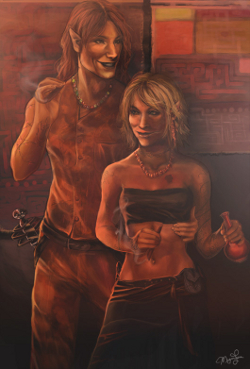
"Legends of the Fist"
Player artwork by Biscuits
Society
The only permanent residents of Luir's Outpost are the family members and employees of House Kurac. The House is the only one of the Great Merchant Houses to have its own major outpost, and also the only House which welcomes people of every civilized race into its employ.
Like employees, visitors come from all over the Known World, representing every race and culture, the Outpost particularly serving as a point for human and elven tribes to come together for trade. While this mixture sometimes causes tension, "The Fist" of Kurac (its military) keeps the Outpost peaceful, for the most part.
And there are other things than conflict to occupy visitors. Nearly everywhere you go in the 'Post you'll smell the pungent scent of someone smoking spice, House Kurac's main ware. Gambling, prostitution, and heavy drinking also feature prominently in this frontier outpost's entertainment.
Economy
The only real economy of the Outpost is trade. The riches of Kurac, second-wealthiest of the merchant houses, flows back to here as does the trade from scores of tribes. While many of the elven tribes see the smaller elven trading post in the tablelands as their primary market, human tribes (and many other elven tribes) sell their wares in the yard at the Outpost. Also all trade between the northlands and the southlands passes through the Outpost, often doing brisk sales while resting on their journey.
The raiders and bandits that prey on this trade also often come to the Outpost to sell their ill-gotten gains and buy supplies and drink. As long as they do not practice their professions too close to the Outpost itself Kurac turns a blind eye to these people, making Luir's Outpost a rough place where some of the worst scum of Zalanthas can be found.
Government
House Kurac is run by a ruling Council and they also control the Outpost. Few outside of Kurac know who is on this Council, and those in Kurac will not answer such questions (other than, perhaps, with a sword for those overly curious).
The enforcement of the law in the Outpost is carried out my the military of the House. They can be easily identified by their dun-colored cloaks. Military leaders wear special leather armbands branded with the signs of Kurac as well as patches or boards on their shoulders to identify their ranks. It is well known that Sergeants wear patches while those higher in ranks wear boards of various design.
The business of the House is handled by black-cloaked merchants and agents, and those wearing more ornate cloaks (black with scarlet trim or scarlet with black trim) are senior in rank and should be treated with as much respect as nobles in the city states. Certainly few military personnel would hesitate to cut down anyone insulting Kurac by dealing roughly with these illustrious people. Those wearing robes of embroidered grey and scarlet are family members of some note and should likewise be treated with respect. Family members are often addressed with the honorific suffixes -da or -di (for males and females respectively).
The Outpost attempts to remain neutral with regards to both Allanak and Tuluk, although alliances are often made (and just as often broken). Known for being somewhat disreputable, the House Kurac is not truly trusted by many although its wealth and the usefulness of its services and goods means that it is generally tolerated.
In general, common sense applies to dealings within the Outpost. Those going about heavily cloaked or veiled when no storm blows will be seen as suspicious and may be detained and similarly those openly wielding weapons may be seen as potential troublemakers. In general the best advice is to do nothing to attract the attention of the military, especially since many of them use a variety of spices that might make them more aggressive and less rational than the common soldier.
One law of note is that insulting House Kurac is considered treason much like insulting the Highlord Tektolnes would be in Allanak. Other laws come and go, and one of the best ways to learn the current regulations is to consult Kuraci personnel in the inn.
What You Know If You're From Red Storm Village
Geography
Red Storm is the largest village in the far south of the Known World. It is in the middle of a desert wasteland that frequently howls with raging sandstorms, but is nevertheless a desirable place because of the mind-altering spice that can be sifted from deposits in the sand. To the south is the Sea of Silt, also known as the Sea of Eternal Dust, which can only be navigated with silt skimmers. To the east is a smaller, inaccessible village imaginatively called Red Storm East. Not far to the north is the massive city-state of Allanak.
Society
Life in the village is grim. People can make a quick coin by gathering spice, but it is often a fruitless and demanding task. The mixture of elation and depression on the faces of the spice hunters as they come back into the village after a long day sifting through the sands mirrors the bittersweet nature of life here. The abysmal weather makes for an unpleasant living. Still, many find greater freedom here than they do in other places--particularly Allanak. While the soldiers wield life-and-death authority on anyone who steps inside the walls, they do not impose themselves arbitrarily in the way that city-state templars often do.
Most of the people in Red Storm Village are outcasts of one sort or another. Many raider bands operate out of the village, though the Sand Lord does not tolerate raiding close to the village. Escaped gladiators and other slaves may be considered higher profile, but they do not make up the majority of the village population. Most civilians in Red Storm Village are spice hunters, farmers, wagon personnel, or Kuraci personnel. While the Kuraci have a high profile in the village, they are not the law.
-

"The Stormer"
Player artwork by Briar
While it would be fair to say that most people in Red Storm Village are at least nominally anti-Allanak, there is no changing the fact that Allanak provides a major source of income for the Sand Lord, and so people just keep quiet and get on with their lives. Most who live here have been through hard times, and know better than to complain when they have at least a roof over their heads and bread to eat.
Economy
The biggest natural resource in the area is spice, so House Kurac maintains a significant presence in the village. It is not the biggest business in the village, however. The biggest business in the village is the Sand Lord's own operation, which supplies wheat to other parts of the Known World-- most notably Allanak. Large wagons travel regularly from Red Storm Village to the east, to a place known as Red Storm East. Very few people have actually been there, but it seems to be another large village that grows wheat, and is also under the Sand Lord's rule. Wagons also make regular trips northwards, bringing grain to supplement the Allanaki farms.
Government
Red Storm Village has old but strong stone walls and is heavily guarded by the Sand Lord, its mysterious, never-seen ruler, and his militia. The Red Storm Militia are a rough-looking but capable force, and they have a somewhat erratic view on some things. Generally speaking, if you are caught committing a crime in Red Storm Village, your life is at stake. The militia recognize that not all outbursts need to be punished by having your head on a stake, however; brawling in the tavern is normally something that is ignored, though not if it turns to heavy fighting. The general rule in Red Storm Village is that you leave everyone else alone, and they leave you alone. It is rumored that several of the high-ranking militia were former gladiators or slaves.
While the Sand Lord allows people like magickers into his village, any casting of spells or use of other strange powers in the village, or the immediately surrounding area, is a crime. In any case, such people tend to hide their identities well, because although the Red Storm Militia may leave them alone, there is no guarantee that a band of raiders will not be waiting for them a few leagues out of the village. The same goes for anyone openly belonging to one of the Allanaki noble Houses, or other such groups. They will be left alone while in the village, unless they cause trouble, but there will likely be several hostile people waiting for them some distance outside, since many of the citizens here are escapees from the oppression of Allanak, and hate their former oppressors with a vengeance.
Village though it is, there are many alleys and small paths in Red Storm, and some of these can be extremely dangerous. Just because violence is frowned upon by the militia does not mean that they will always be there to protect innocent passersby. As mentioned above, the law can be erratic ... but sometimes, it just takes time for the law to catch up with someone being stupid. One of the main lessons you've learned growing up in Red Storm is that the smart thing to do is leave others alone and not ask too many questions, in case you annoy the wrong person.
What You Know If You're From The Labyrinth
Geography
The Labyrinth (or 'rinth) is the common slang term used for the northernmost quarter of the city of Allanak, due to the maze of alleyways that threads about the ramshackle buildings within it. Once it was merely the quarter for the lower classes of Allanak. But over the last several hundred years as the rich became progressively richer and the poor poorer, the quarter has degenerated into a decayed and disease ridden slum.
-
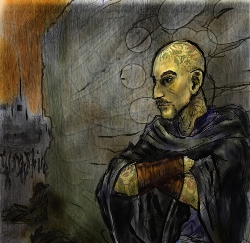
"Of the Streets"
Player artwork by Dig
Geographically and demographically the 'rinth is made up of two distinct areas - the Westside and the Eastside. The Westside's population is, for the most part, made up of humans while the Eastside's is mainly elves. This has led to a futher sub-division of 'rinth culture as the two main population groups generally keep to themselves and view each other with mistrust and suspicion despite the fact that the general social structure and day-to-day life for most occupants of the 'rinth is the same.
Society
If you're from the Labyrinth, your character has occupied a position of abject poverty and squalor for all of his or her life. Hunger and violence (racial or purely random) has been a daily occurence. Disease perpetually stalks the streets. Your character knows that street gangs roam wild in the winding alleyways, looking for the lone and unsuspecting, and that packs of children have been known to kill the unwary for nothing more than the hope of a scrap of food. In short, life in the 'rinth has been a difficult test for your character. There is no rule to creating a 'rinther character's personality but the above should be reflected when creating their history and characteristics.
It is important to note that due to the rough conditions in the 'rinth many people (both PC and NPC) might not wish you well. People living there are desperate and may try to take advantage of you. Don't let this discourage you - part of being a 'rinther lies in the challenge of dealing with and overcoming this harshness. Thinking, dressing and acting like a 'rinther will greatly help you in this regard.
Given the above, it is no surprise that the average 'rinther will generally treat a fellow inhabitant of the alleys with considerable suspicion and mistrust upon first meeting them. This attitude is often magnifed when an Westsider meets a Eastsider or vice versa. However, this Westside - Eastside mutual suspicion would probably not be as great as a situation where a 'rinther meets a person who is not from the alleys. All other things being equal, a 'rinther would be more likely to side with another 'rinther than somebody not from the alleys. However, this "bond" is loose at best and, as a 'rinther, not one you'd like to have to depend on.
The 'rinth is more than just a home to Allanak's desperate, unwanted, or racially undesirable people. Many generations of inhabitants of the 'rinth have been born, lived and died in Tektolnes' chamber-pot of human life. It is common knowledge that darker, more unsavoury organizations have embraced the chaos and turmoil of the 'rinth and made it their home. This, coupled with the fact that the general citizenry and militia of Allanak avoid this dark ghetto, has given most 'rinthers an insular "them vs. us" attitude. A person not from the 'rinth found wandering the alleys would be viewed with a deal of suspicion. After all, why would any sane person willingly come into such a filthy and dangerous place? This semi-isolation from the rest of the city also leaves the average 'rinther with, at best, a scant knowledge of what's what outside the 'rinth. The doings of noble houses, merchant houses, templars, etc. are of little meaning to most 'rinthers, whose chief concerns are getting food in their bellies and staying alive.
Economy
Since certain sectors of the Allanaki economy have gone underground, the 'rinth is where many of the city's small to medium-sized "business contracts" are negotiated, although detailed knowledge of this might not be well known to the average inhabitant. What is evident, however, is that money does trickle into the alleys and at least some of the residents can afford an ale or two occasionally in a local alley tavern.
-
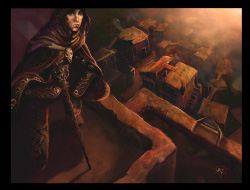
"Gin of the Alleys"
Player artwork by Biscuits
Wild gangs do indeed roam the streets but the majority of inhabitants are just trying to get by - however they can. Murder is an everyday occurrence but far more common activities are scavenging, stealing, pick-pocketing, mugging, scamming, black market/spice dealing, etc.
Government
As stated previously, life is a constant struggle in the 'rinth. Resources, food, and money are scarcer here than in any other city in the Known World. Naturally, this leads to "competition" for whatever is available in the alleys. As the militia of the city do not dare enter the alleys, this desperate competition can take the form of threats, intimidation, or outright violence. This is not to say, however, that all 'rinthers are psychopathic mass-murderers. Creating a 'rinther character does not give you licence to go on a killing spree through the alleys. If a lone person was to gain such a reputation it is likely that he or she would be dealt with by a number of "concerned citizens".
There are several groups of a shady nature operating in the 'rinth. Growing up, your character would have heard snatches of their various dealings and know that there are groups both Eastside and Westside. The exact details of these groups are closely guarded, however, and as a 'rinther you know well that it doesn't pay to take too much of an interest in their dealings lest they take an interest in you. Of course if your character has something to offer such groups this interest might not be of the fatal variety.
What You Know If You're From The Tablelands
This is a guide to what is commonly known by the residents of the Tablelands, a wildnerness inhabited by many desert tribes, both human and elven.Geography
The Tablelands is a wilderness of sheer red cliffs, high sandstone mesas, and shadowy canyons between. Major landmarks of the Tablelands include the desert elf outpost to the north. To the south and west lies the Valley of Xytrix-Za, once home for a thriving mantis civilization. Within the last couple centuries, however, the city-state of Allanak has claimed the valley and posted troops there. The mantis have, rumors hold, migrated west and south. Near the valley entrance is an outpost that was originally a bandit stronghold, but which has become tamer with the cautionary influence of Allanak nearby.
-
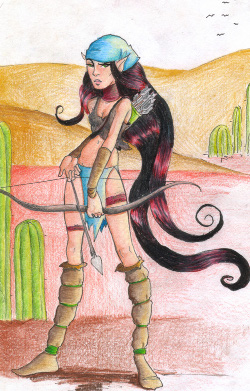
"Desert Archer"
Player artwork by Ourla
In the center of the Tablelands lies the gith mesa. The gith like to deal with outsiders by slaying and consuming intruders. They do deal on occasion with the Red Fangs elven tribe. Gith technology is crude at best, and the quality of their wares is poor.
Society
If you grew up in the Tablelands, you are either a member of the nomadic human tribes or the multiplicity of elvish tribes that exist there. If human, you may be a member of one of the main tribes, the Al Seik, Benjari, or Jul Tavan, or a member of one of the small splinter groups that have split off from them over the years. If you are an elf, you have a variety of possibilities, since elvish tribes come and go swiftly.
The human tribes usually speak Bendune, a rich and poetic language which bears some resemblance to the elven speech, and even more to the trade language known as Cavilish. Bendune is not much known outside the Tablelands and Luir's Outpost, but is a necessity for survival in that area. While a few of the elves of the Tablelands have picked up Bendune from their human neighbors, all elves speak allundean. There are a multitude of elvish tribes on the Tablelands: the Akei'ta Var, the Red Fangs, the Soh Lanah Kah, and the Sun Runners, to name a few. Usually a new tribe occurs when a group splits off from a larger tribe, and often the name of the new tribe commemorates the split.
Life on the Tablelands is precarious at best. Fierce creatures, including deadly dujat worms, anakore that lurk beneath the sands waiting to pull down unwary travellers, wezers that sting their victims with paralyzing poison and drag them home to their hives, and hulking half-intelligent braxat, fill its canyons and mesas. But it is a compelling environment as well, full of cacti and desert vegetation seen nowhere else in the Known World. Quirri, large black felines, slink through the dune shadows here, and long-necked durrit the size of dwarves dig for grubs under the tumbled boulders. A few oases lie like green pools where shelter is available, but for most of its denizens, water is a scarce and valued commodity.
Economy
Once primarily a Blackwing outpost, other tribes have set up trading in the desert elf outpost, and now it has become a common meeting place for the various tribes as well as occasional merchants from elsewhere looking for goods.
Much trading also occurs in Luir's Outpost, which lies on the North Road to the east of the Tablelands. Run by House Kurac, the Outpost is host to a variety of merchants from across the Known World.
Government
Each tribe in the Tablelands governs itself, as all past attempts to create unity amongst tribes have ultimately failed. The main rule of thumb in the Tablelands is to watch your tribe's back and don't cause trouble that will come back to harm them.
Next guide:
The Walkthrough will help with your first few days playing.
